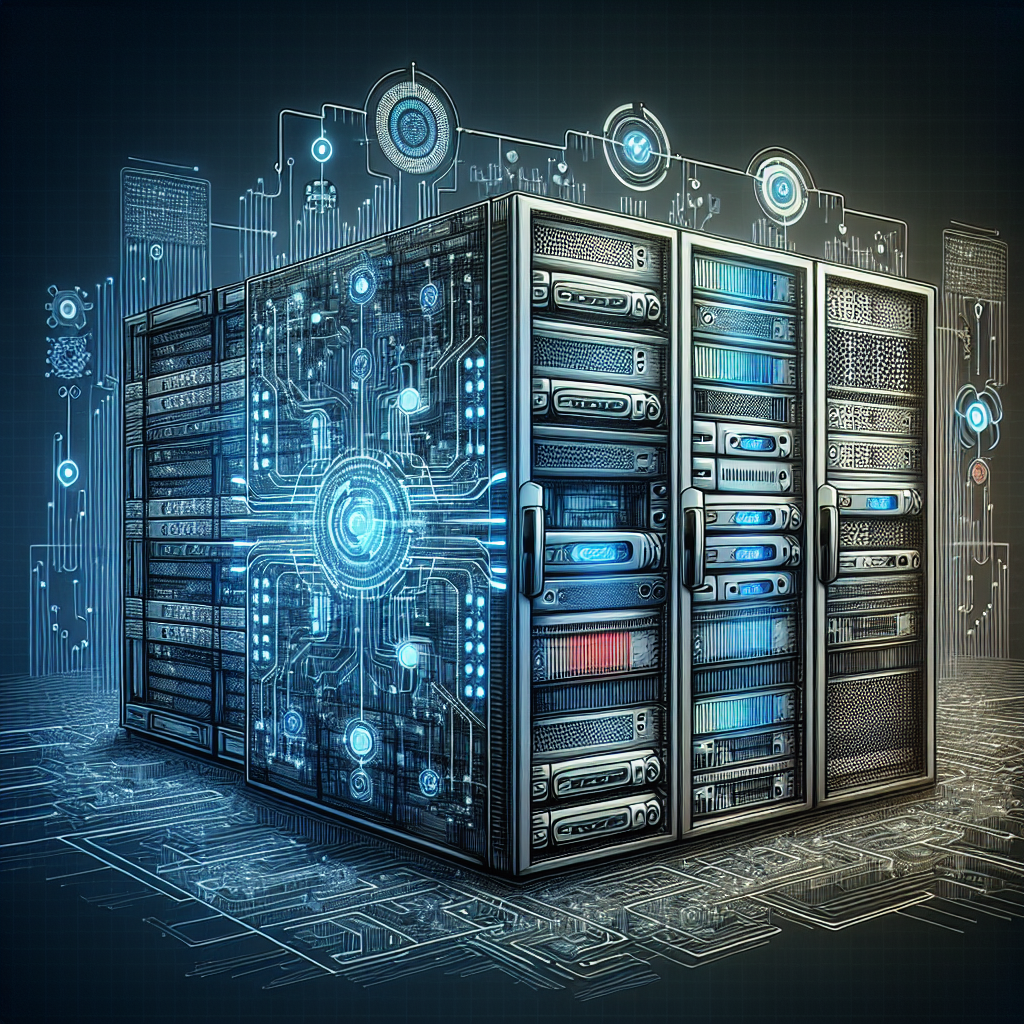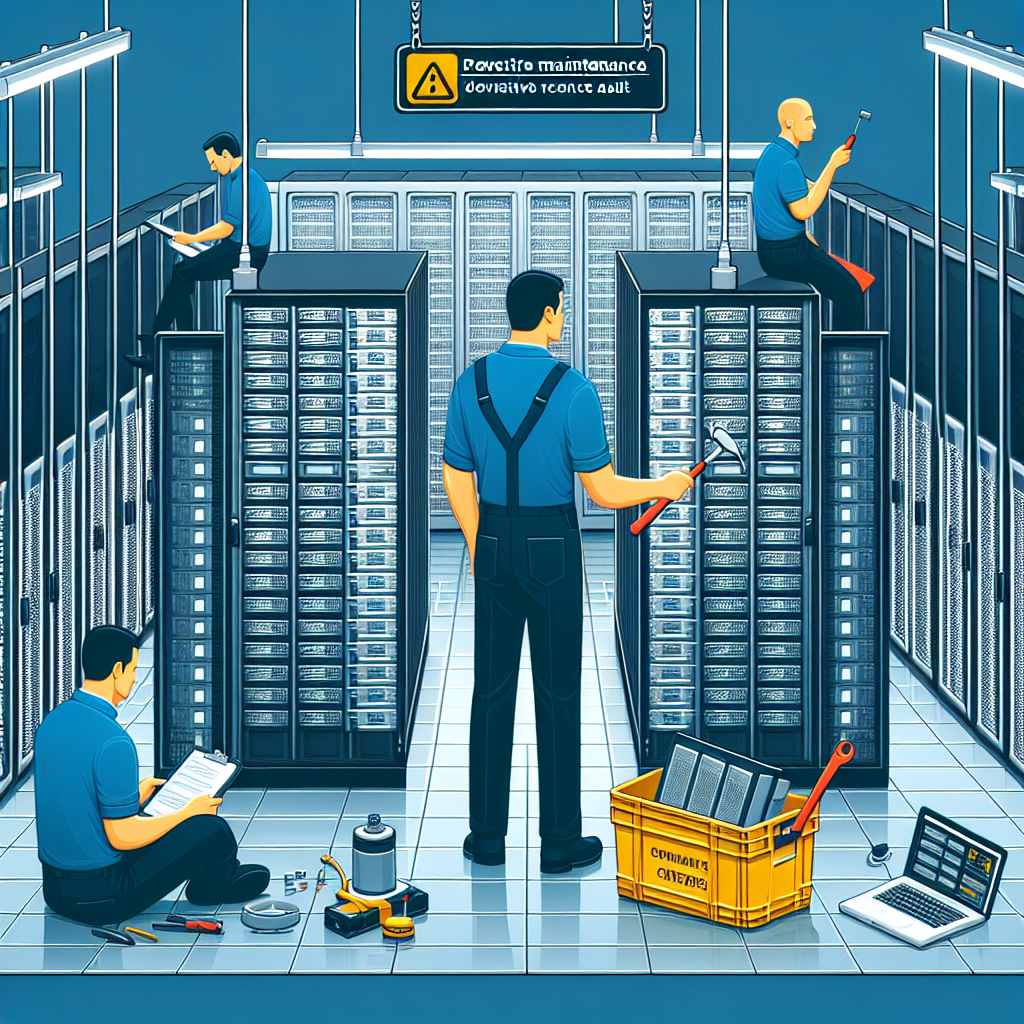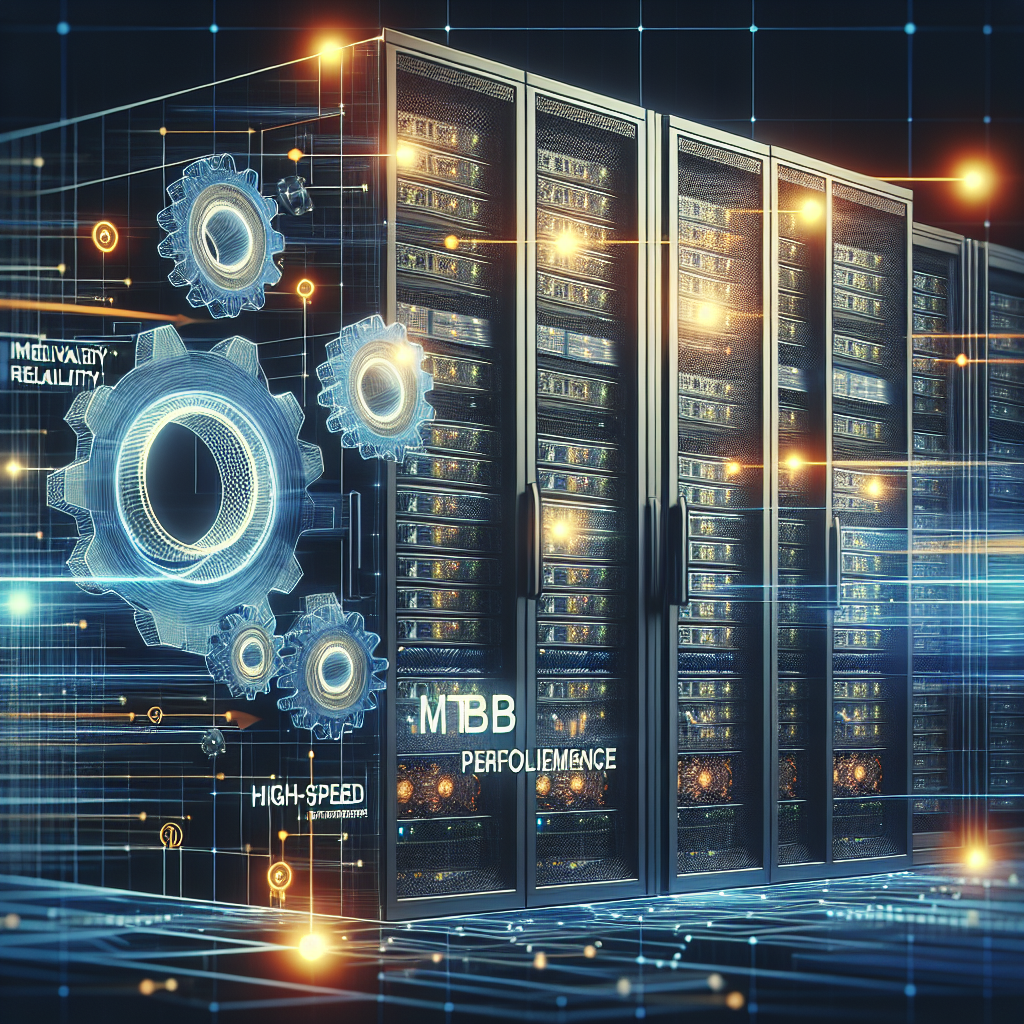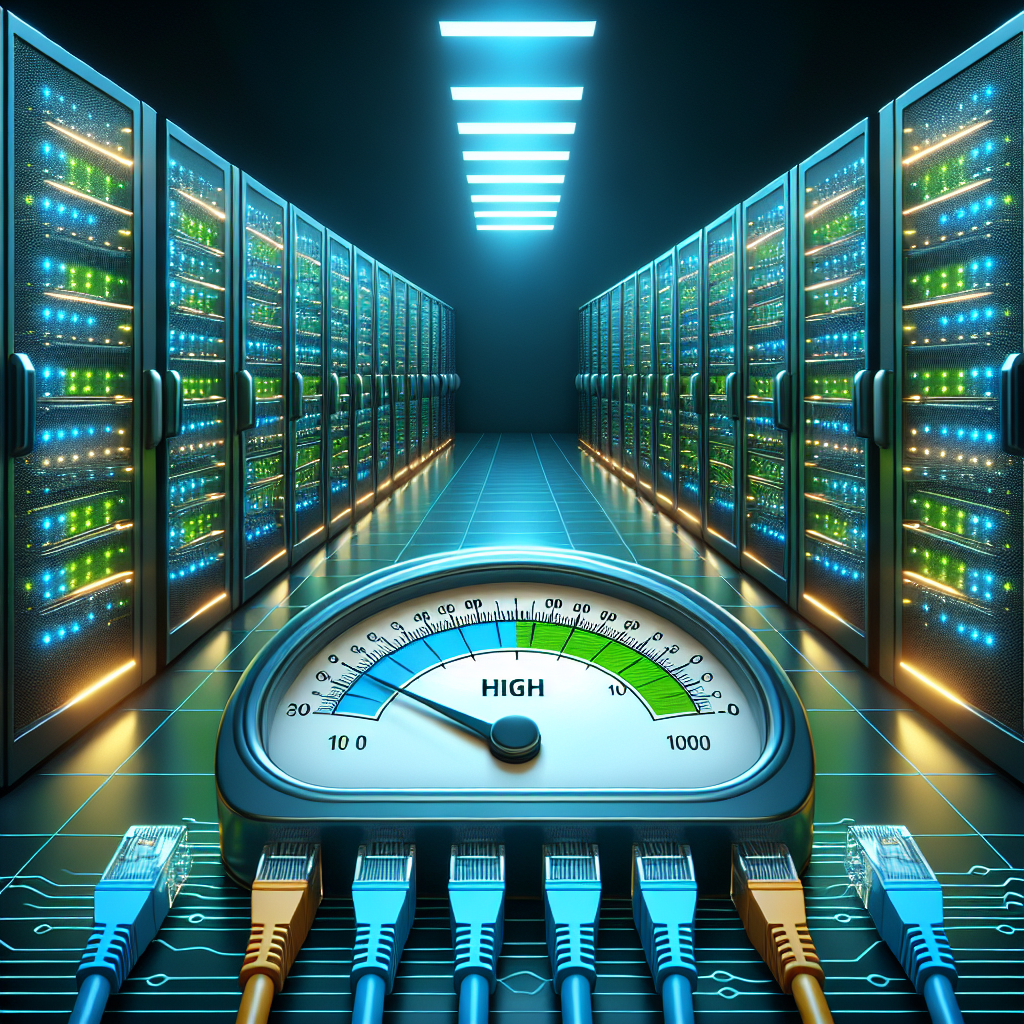Your cart is currently empty!
Tag: Data Center Facilities Management

Predictive Maintenance: A Game-Changer for Data Center Operations
In today’s fast-paced digital world, data centers are an essential part of our everyday lives. They store and process vast amounts of data, ensuring that everything from our social media feeds to our online shopping experiences run smoothly. However, the maintenance of these data centers is crucial to their continued operation and efficiency. This is where predictive maintenance comes in.Predictive maintenance is a game-changer for data center operations, as it utilizes advanced analytics and machine learning algorithms to predict when equipment is likely to fail and proactively address issues before they occur. By using real-time data and historical patterns, predictive maintenance can identify potential problems early on, allowing data center operators to schedule maintenance tasks at optimal times, reduce downtime, and extend the lifespan of equipment.
One of the key benefits of predictive maintenance is its ability to save time and money. By predicting when equipment is likely to fail, data center operators can plan maintenance activities in advance, avoiding costly emergency repairs and unplanned downtime. This not only reduces operational costs but also improves the overall efficiency of the data center.
Another advantage of predictive maintenance is its ability to improve data center reliability and availability. By proactively addressing potential issues before they occur, data center operators can ensure that critical systems are always up and running, minimizing the risk of data loss or service disruptions. This is especially important in industries where downtime can have serious consequences, such as healthcare or finance.
Furthermore, predictive maintenance can also help data center operators make more informed decisions about equipment replacement and upgrades. By analyzing historical data and performance trends, operators can identify which equipment is nearing the end of its lifespan and plan for replacement or upgrades accordingly. This can help prevent costly downtime and ensure that data centers are always operating at peak performance.
Overall, predictive maintenance is a game-changer for data center operations. By leveraging advanced analytics and machine learning algorithms, data center operators can proactively address equipment issues, improve reliability and availability, and make more informed decisions about equipment maintenance and upgrades. In today’s digital age, where data centers are the backbone of our connected world, predictive maintenance is essential for ensuring that these critical facilities continue to operate efficiently and effectively.

Top Tips for Conducting Data Center Preventative Maintenance Audits
Data centers are the backbone of modern businesses, housing critical IT infrastructure and data that keep operations running smoothly. To ensure optimal performance and reliability, regular preventative maintenance audits are essential. These audits help identify potential issues before they become major problems, leading to costly downtime and disruptions. Here are some top tips for conducting data center preventative maintenance audits.1. Develop a comprehensive checklist: Before starting the audit, create a detailed checklist of all the equipment and systems that need to be inspected. This checklist should include items such as cooling systems, power distribution units, UPS systems, and fire suppression systems. Having a comprehensive checklist will help ensure that no critical components are overlooked during the audit.
2. Schedule regular audits: Preventative maintenance audits should be conducted on a regular basis to catch any potential issues early on. Depending on the size and complexity of your data center, audits can be done monthly, quarterly, or annually. Consistent audits will help you stay on top of maintenance tasks and ensure that your data center is operating at peak efficiency.
3. Use specialized tools and equipment: To conduct a thorough audit, it’s important to use specialized tools and equipment. This may include thermal imaging cameras, airflow meters, and power monitoring devices. These tools will help you identify any hotspots, airflow obstructions, or power anomalies that could lead to equipment failures or downtime.
4. Document findings and recommendations: During the audit, make sure to document all findings and recommendations. This documentation will provide a baseline for future audits and help track any changes or improvements over time. It’s also important to prioritize recommendations based on the severity of the issues identified and allocate resources accordingly.
5. Train staff on best practices: Data center staff play a crucial role in maintaining the facility and ensuring that preventative maintenance tasks are carried out effectively. Provide regular training sessions on best practices for data center maintenance, including proper cleaning procedures, equipment inspections, and emergency response protocols. Well-trained staff can help prevent issues before they escalate and minimize downtime.
6. Partner with a professional service provider: If conducting preventative maintenance audits in-house is not feasible, consider partnering with a professional service provider. These providers have the expertise and resources to conduct thorough audits and implement recommendations effectively. They can also provide ongoing support and maintenance services to keep your data center running smoothly.
In conclusion, conducting regular preventative maintenance audits is essential for ensuring the reliability and performance of your data center. By following these top tips, you can identify potential issues early on, address them proactively, and minimize the risk of costly downtime. Invest in proper tools, documentation, and training to maintain a well-functioning data center that meets the needs of your business.

MTTR Metrics: How to Monitor and Improve Data Center Repair Times
MTTR Metrics: How to Monitor and Improve Data Center Repair TimesIn today’s fast-paced technology-driven world, data centers play a crucial role in ensuring the smooth operation of businesses. Any downtime in a data center can lead to significant financial losses and damage to a company’s reputation. That’s why monitoring and improving Mean Time to Repair (MTTR) metrics is essential for data center operators.
MTTR is a key performance indicator that measures the average time it takes to repair a system or component after a failure. By monitoring MTTR metrics, data center operators can identify areas where improvements are needed to reduce repair times and minimize downtime.
There are several ways to monitor and improve MTTR metrics in a data center:
1. Establish a baseline: The first step in improving MTTR metrics is to establish a baseline measurement of current repair times. This will help data center operators track progress and identify areas for improvement.
2. Implement monitoring tools: Utilize monitoring tools to track the status of systems and components in the data center in real-time. This will help identify potential issues before they escalate into major failures, reducing repair times.
3. Prioritize repairs: Develop a system for prioritizing repairs based on the impact on business operations. By focusing on critical systems first, data center operators can reduce downtime and improve MTTR metrics.
4. Implement automation: Automation can help streamline repair processes and reduce the time it takes to diagnose and fix issues in the data center. Implementing automation tools can significantly improve MTTR metrics.
5. Train staff: Ensure that data center staff are properly trained in troubleshooting and repairing systems and components. Providing ongoing training and education can help improve repair times and overall data center performance.
6. Analyze root causes: Conduct root cause analysis to identify the underlying reasons for system failures. By addressing the root causes of issues, data center operators can prevent future failures and improve MTTR metrics.
7. Continuously improve: Regularly review and evaluate MTTR metrics to identify areas for improvement. Implementing a continuous improvement process can help data center operators optimize repair times and enhance overall performance.
Monitoring and improving MTTR metrics in a data center is essential for ensuring the reliability and efficiency of operations. By establishing a baseline, implementing monitoring tools, prioritizing repairs, implementing automation, training staff, analyzing root causes, and continuously improving processes, data center operators can reduce repair times and minimize downtime. Ultimately, improving MTTR metrics can lead to increased uptime, reduced costs, and improved customer satisfaction.

Understanding Data Center MTBF: How to Improve Reliability and Performance
Data centers are the backbone of modern businesses, housing the servers and networking equipment that support critical operations and services. As such, ensuring the reliability and performance of data centers is paramount to maintaining business continuity and maximizing productivity. One key metric that is used to measure the reliability of data center equipment is Mean Time Between Failures (MTBF).MTBF is a measure of the expected lifespan of a piece of equipment, representing the average time between failures. A higher MTBF indicates greater reliability, as it means the equipment is less likely to experience a failure within a given timeframe. Understanding and improving MTBF is crucial for data center operators to minimize downtime and disruptions.
There are several ways to improve the reliability and performance of data center equipment to increase MTBF:
1. Regular maintenance and inspections: Regular maintenance and inspections can help identify and address potential issues before they lead to equipment failures. Implementing a proactive maintenance schedule can extend the lifespan of equipment and reduce the likelihood of unexpected failures.
2. Temperature and humidity control: Data center equipment is sensitive to temperature and humidity levels, which can impact its performance and lifespan. Maintaining optimal environmental conditions within the data center can help prevent overheating and other issues that can lead to failures.
3. Redundancy and backup systems: Implementing redundancy and backup systems can help mitigate the impact of equipment failures by automatically switching to backup systems in the event of a failure. Redundant power supplies, cooling systems, and networking equipment can help ensure continuous operation and minimize downtime.
4. Monitoring and analytics: Implementing monitoring and analytics tools can help data center operators track the performance and health of equipment in real-time. By monitoring key metrics such as temperature, power usage, and network traffic, operators can identify potential issues early and take proactive measures to prevent failures.
5. Regular testing and simulations: Regularly testing equipment and conducting simulations of potential failure scenarios can help data center operators identify weaknesses in their systems and develop contingency plans. By proactively testing and simulating failure scenarios, operators can better prepare for unexpected events and minimize downtime.
In conclusion, understanding and improving data center MTBF is essential for ensuring the reliability and performance of data center equipment. By implementing proactive maintenance practices, controlling environmental conditions, implementing redundancy and backup systems, monitoring equipment performance, and conducting regular testing and simulations, data center operators can improve MTBF and minimize downtime. Investing in reliability and performance improvements can help businesses maintain business continuity and maximize productivity in today’s digital age.

Investing in Data Center Resilience: Cost vs. Benefit Analysis
Data centers are the backbone of modern businesses, serving as the hub for storing, processing, and managing critical data. With the increasing reliance on digital technologies, the need for data center resilience has become more important than ever. Investing in data center resilience involves implementing measures to ensure that the data center can withstand and recover from disruptions such as power outages, natural disasters, cyber attacks, and equipment failures.While investing in data center resilience can incur significant costs, the benefits far outweigh the expenses. A cost vs. benefit analysis can help organizations determine the value of investing in data center resilience.
Costs of Data Center Resilience:
1. Infrastructure Upgrades: Implementing resilient infrastructure such as redundant power supplies, cooling systems, and network connections can be costly. These upgrades ensure uninterrupted operations and minimize downtime in case of failures.
2. Security Measures: Investing in security measures such as firewalls, intrusion detection systems, and access controls can add to the overall cost of data center resilience. However, these measures are essential for protecting sensitive data and preventing cyber attacks.
3. Monitoring and Maintenance: Regular monitoring and maintenance of data center infrastructure are necessary to ensure optimal performance and resilience. This includes conducting routine inspections, testing backup systems, and updating software to mitigate vulnerabilities.
Benefits of Data Center Resilience:
1. Minimized Downtime: One of the primary benefits of investing in data center resilience is the reduction of downtime. By implementing redundant systems and disaster recovery plans, organizations can minimize the impact of disruptions and ensure continuous operations.
2. Data Protection: Data is a valuable asset for businesses, and losing critical data can have severe consequences. Investing in data center resilience helps protect data from loss or corruption, ensuring business continuity and compliance with regulatory requirements.
3. Reputation Management: Downtime and data breaches can damage a company’s reputation and erode customer trust. By investing in data center resilience, organizations can demonstrate their commitment to reliable service and data security, enhancing their reputation in the market.
4. Cost Savings: While investing in data center resilience may require upfront costs, the long-term benefits can result in cost savings. Minimized downtime, data loss, and reputation damage can lead to increased productivity, reduced operational expenses, and improved customer retention.
In conclusion, investing in data center resilience is essential for ensuring the continuity and security of business operations in today’s digital age. While the costs of implementing resilient measures may seem high, the benefits far outweigh the expenses. Conducting a cost vs. benefit analysis can help organizations justify the investment in data center resilience and ultimately protect their valuable data and reputation.

Maximizing Data Center Performance with Proactive Facilities Management
In today’s digital age, data centers are the backbone of virtually every organization. They house and manage the critical IT infrastructure that keeps businesses running smoothly. With the increasing reliance on data centers, maximizing performance and efficiency has become a top priority for IT professionals.One key aspect of optimizing data center performance is proactive facilities management. This involves implementing strategies and best practices to ensure that the physical infrastructure supporting the IT equipment is operating at peak efficiency. By taking a proactive approach to facilities management, organizations can reduce downtime, improve energy efficiency, and extend the lifespan of their equipment.
One of the first steps in proactive facilities management is conducting regular assessments of the data center infrastructure. This includes reviewing the layout of equipment, monitoring power and cooling systems, and identifying any potential bottlenecks or points of failure. By regularly assessing the data center environment, IT professionals can identify areas for improvement and take proactive steps to address them before they cause issues.
Another key aspect of proactive facilities management is implementing a robust maintenance program. This includes regular inspections, cleaning, and servicing of equipment to ensure that it is operating at peak efficiency. By performing routine maintenance tasks, organizations can prevent unexpected failures and extend the lifespan of their equipment.
In addition to regular maintenance, organizations can also benefit from implementing advanced monitoring and management tools. These tools can provide real-time visibility into the performance of the data center infrastructure, allowing IT professionals to quickly identify and address any issues that arise. By proactively monitoring the data center environment, organizations can prevent downtime and optimize performance.
Furthermore, organizations can also benefit from implementing energy-efficient practices in their data centers. By optimizing cooling systems, consolidating servers, and implementing virtualization technologies, organizations can reduce energy consumption and lower operating costs. By maximizing energy efficiency, organizations can not only reduce their environmental footprint but also improve the overall performance of their data center.
In conclusion, proactive facilities management is essential for maximizing data center performance. By conducting regular assessments, implementing a robust maintenance program, and utilizing advanced monitoring tools, organizations can optimize their data center infrastructure and ensure that it operates at peak efficiency. By taking a proactive approach to facilities management, organizations can minimize downtime, improve energy efficiency, and extend the lifespan of their equipment. Ultimately, proactive facilities management is key to ensuring that data centers continue to support the evolving needs of modern businesses.

Measuring Success: Key Metrics for Data Center IT Operations
In today’s digital age, data centers play a critical role in the operations of businesses and organizations. They are the backbone of IT infrastructure, housing and managing vast amounts of data that are essential for daily operations. As such, measuring the success of data center IT operations is crucial for ensuring efficiency, reliability, and performance.There are several key metrics that can be used to measure the success of data center IT operations. These metrics provide valuable insights into the performance and effectiveness of the data center, helping organizations identify areas for improvement and optimization. Below are some key metrics that are commonly used to measure the success of data center IT operations:
1. Uptime: Uptime is one of the most important metrics for data center IT operations. It measures the amount of time that the data center is operational and available to users. High uptime rates are crucial for ensuring that data and applications are accessible at all times, minimizing downtime and disruptions.
2. Power Usage Effectiveness (PUE): PUE is a metric that measures how efficiently a data center uses energy. A low PUE indicates that the data center is operating efficiently and effectively. By monitoring PUE, organizations can identify opportunities to reduce energy consumption and lower operating costs.
3. Server Utilization: Server utilization measures the percentage of server resources that are being utilized at any given time. High server utilization rates indicate that resources are being efficiently utilized, while low utilization rates may indicate that resources are underutilized. By optimizing server utilization, organizations can improve efficiency and reduce costs.
4. Cooling Efficiency: Cooling efficiency is another important metric for data center IT operations. It measures how effectively the data center’s cooling systems are maintaining optimal temperatures for equipment. By monitoring cooling efficiency, organizations can identify opportunities to improve cooling systems and reduce energy consumption.
5. Data Transfer Rates: Data transfer rates measure the speed at which data is transferred within the data center. High data transfer rates are crucial for ensuring fast and reliable data access. By monitoring data transfer rates, organizations can identify bottlenecks and optimize data transfer processes.
6. Security and Compliance: Security and compliance metrics measure how effectively the data center is protecting data and complying with regulations and industry standards. By monitoring security and compliance metrics, organizations can ensure that data is secure and protected from unauthorized access.
Overall, measuring the success of data center IT operations is essential for ensuring that data centers are operating efficiently, reliably, and securely. By monitoring key metrics such as uptime, PUE, server utilization, cooling efficiency, data transfer rates, and security and compliance, organizations can identify opportunities for improvement and optimization, ultimately leading to a more successful and effective data center operation.

The Role of Automation in Streamlining Data Center Lifecycle Management
Data centers are the backbone of modern businesses, housing the critical infrastructure and applications that keep organizations running smoothly. As technology continues to advance at a rapid pace, the complexity and scale of data center operations have also increased significantly. In order to meet the demands of today’s digital economy, organizations are turning to automation to streamline the lifecycle management of their data centers.Automation plays a crucial role in data center lifecycle management by reducing manual intervention, improving efficiency, and ensuring consistency in operations. By automating routine tasks such as provisioning, monitoring, and maintenance, organizations can free up their IT staff to focus on more strategic initiatives. This not only increases productivity but also minimizes the risk of human error, leading to improved reliability and uptime.
One of the key benefits of automation in data center lifecycle management is the ability to scale operations quickly and efficiently. As data center infrastructure grows and changes, automation tools can automatically adjust capacity, allocate resources, and deploy new services without the need for manual intervention. This agility is essential in today’s fast-paced business environment, where organizations need to respond to changing demands and market conditions at a moment’s notice.
Automation also plays a critical role in ensuring compliance and security in data center operations. By implementing automated processes for monitoring and enforcing policies, organizations can reduce the risk of data breaches and ensure that their infrastructure meets regulatory requirements. This not only protects sensitive information but also helps organizations avoid costly fines and reputational damage.
Furthermore, automation can help organizations optimize resource utilization and reduce costs in their data centers. By automatically scaling resources based on demand, organizations can avoid over-provisioning and underutilization, leading to significant cost savings. Automation tools can also identify and remediate inefficiencies in the data center, such as underused servers or inefficient cooling systems, further reducing operational expenses.
In conclusion, automation plays a crucial role in streamlining data center lifecycle management by improving efficiency, scalability, compliance, and cost-effectiveness. By automating routine tasks and processes, organizations can optimize their data center operations, increase productivity, and ensure the reliability and security of their infrastructure. As technology continues to evolve, automation will become increasingly essential for organizations looking to stay competitive in the digital age.

Driving Efficiency in the Data Center: Tips for Success
In today’s digital age, data centers are the backbone of most organizations. They store and process vast amounts of data, powering everything from email communication to online shopping. With the increasing demand for data storage and processing power, it’s more important than ever for data centers to operate efficiently.Driving efficiency in the data center not only saves money but also reduces environmental impact. By optimizing energy usage, improving cooling systems, and streamlining operations, data center managers can achieve significant cost savings and contribute to a greener planet. Here are some tips for success in driving efficiency in the data center:
1. Virtualization: One of the most effective ways to improve efficiency in the data center is through virtualization. By consolidating multiple physical servers onto a single virtual server, organizations can reduce the number of physical servers needed, leading to lower energy consumption and reduced cooling requirements.
2. Energy-efficient hardware: Investing in energy-efficient servers, storage devices, and networking equipment can significantly reduce energy usage in the data center. Look for Energy Star certified equipment and consider upgrading to more energy-efficient hardware when it’s time for a refresh.
3. Temperature and humidity control: Proper temperature and humidity control are crucial for maintaining optimal conditions in the data center. By implementing hot and cold aisle containment, using energy-efficient cooling systems, and monitoring temperature and humidity levels closely, data center managers can ensure that equipment operates efficiently and reliably.
4. Data center infrastructure management (DCIM): DCIM software can provide valuable insights into energy usage, equipment performance, and capacity planning in the data center. By using DCIM tools to monitor and analyze data center operations, managers can identify areas for improvement and make informed decisions about optimizing efficiency.
5. Renewable energy sources: Consider integrating renewable energy sources, such as solar or wind power, into the data center’s energy mix. By generating clean energy on-site, organizations can reduce their reliance on fossil fuels and lower their carbon footprint.
6. Regular maintenance and updates: Keeping equipment well-maintained and up to date is essential for ensuring optimal efficiency in the data center. Schedule regular maintenance checks, upgrade outdated equipment, and implement software updates to keep operations running smoothly.
7. Staff training and awareness: Educating data center staff on best practices for energy efficiency and sustainability can help drive positive change within the organization. Encourage employees to be mindful of their energy usage, implement energy-saving practices, and contribute ideas for improving efficiency in the data center.
In conclusion, driving efficiency in the data center is a continuous process that requires dedication, investment, and a commitment to sustainability. By implementing these tips for success, organizations can maximize efficiency, reduce costs, and make a positive impact on the environment.

The Human Factor: Why Employee Training is Essential for Data Center Safety
Data centers are critical components of today’s digital world, housing the servers and infrastructure that power the internet and store vast amounts of data. With the increasing reliance on technology and the growing threat of cyber attacks, ensuring the safety and security of data centers has become more important than ever. While investing in state-of-the-art security systems and infrastructure is crucial, one often overlooked aspect of data center safety is employee training.The human factor plays a significant role in data center safety. Employees are the first line of defense against potential risks and threats, and their knowledge and actions can greatly impact the security of the facility. Proper training is essential to ensure that employees are equipped with the skills and knowledge needed to effectively manage and respond to potential risks.
Training employees on best practices for data center safety can help prevent accidents, mitigate risks, and ensure the smooth operation of the facility. This includes training on fire safety protocols, emergency response procedures, physical security measures, and data protection practices. Employees should also be trained on how to identify and report potential security threats, such as unauthorized access or suspicious activities.
Furthermore, employee training can help instill a culture of safety and security within the organization. When employees are educated on the importance of data center safety and understand their role in maintaining it, they are more likely to take the necessary precautions and follow protocols to protect the facility and its data.
In addition to ensuring the safety of the data center, employee training can also have a positive impact on the overall performance and efficiency of the facility. Well-trained employees are more likely to be proactive in identifying and addressing potential issues, leading to fewer downtime incidents and improved productivity.
Ultimately, investing in employee training for data center safety is a wise decision for any organization that values the security of its data and infrastructure. By equipping employees with the knowledge and skills needed to effectively manage and respond to potential risks, organizations can better protect their data centers and ensure the continued operation of their critical systems.
